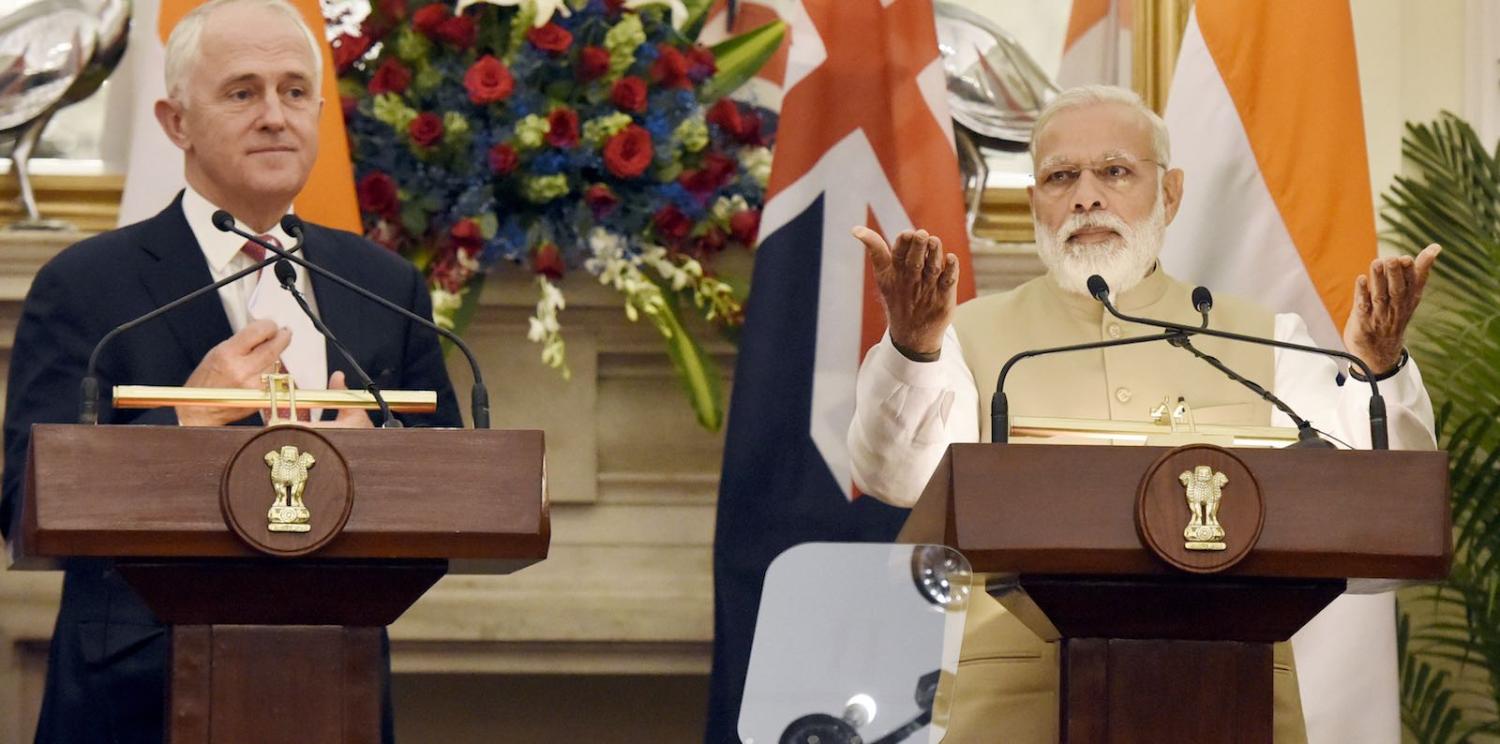Peter Varghese’s independent report on Australia’s economic strategy for India, released by Prime Minister Malcolm Turnbull last week, sounds a confident note for the future of the relationship. Although the focus of the report is trade, geopolitical alignments are one of three pillars on which Varghese’s confidence rests.
India has never upheld the ‘liberal international order’ the way that Australia wants.
But crucial differences between India’s and Australia’s strategic outlooks are missing from the report.
Varghese, who spent four years as Australia’s high commissioner to India, was commissioned by Turnbull to propose an India trade strategy. Geopolitics is only one chapter of an extremely detailed 514-page report.
Geopolitically, Varghese expects a convergence based on three factors. First, that both states are concerned about fading US strategic predominance in the Indo-Pacific, and share fears of Chinese ambitions to replace it. Second, Australia and India both “support a rules-based international order”. And finally, that India can become Australia’s partner in “seeking to forge (inclusive) regional institutions in the Indo-Pacific”.
This leads to the hope that India, the US, Japan, and Australia have a “growing strategic convergence” as “four democracies” in the Indo-Pacific.
There are notes of caution. The report rightly asserts that India is “cautious about pressing a human rights agenda”, is “not interested” in “promoting democracy”, and will maintain its “strategic autonomy”. Nonetheless, it argues that India will “likely to continue to support a liberal international order”.
In this sense, the report concurs with a common liberal assumption in Australian foreign policy that all democratic states will ultimately come to see world order the same way. Canberra has long talked about India as a place with which it has “shared values” and “shared history”. But the relationship has never lived up to these expectations.
India has never upheld the “liberal international order” the way that Australia wants. The key question that Varghese’s report does not address is whether or not India and Australia want the same thing when they say they want a “rules-based order”.
“Rules-based order” has become the dominant catchphrase of Australian foreign policy. In the Australian context, it is a benign term used to promote, and soften, a hierarchical world order from which Australia feels it benefits. India is opposed to this hierarchy.
Australia sees its security as derived from the US and its allies underwriting these “rules” with military force. India is not opposed to rules or laws outright. It argues for non-discriminatory rules as part of a strategy seeking a diffuse, multipolar, or “polycentric” world order in which India is one of many key players and is no longer subordinated from international decision-making.
To put it another way, the current rules benefit Australia more than they do India, and New Delhi would like to rewrite some of those rules. India refuses to sign up to US patent rules so as to protect its pharmaceutical industry, argues for rewriting the nuclear non-proliferation treaty to eliminate its legitimation of a nuclear hierarchy, and seeks a permanent seat on the UN Security Council.
In this sense, political contestation in the Indo-Pacific is far more complicated, and much less rosy for Australia, than Varghese’s report might have it.
As the report’s hopes for a convergence between the US, India, Japan, and Australia demonstrate, Varghese, and likely Canberra, continue to pin hopes on India seeing this “rules-based order”, and the rise of China, the same way that Australia does. Although precisely how Australia should manage the rise of China is debated, there is a bipartisan view that India will prove a reliable partner. And yet, while power transitions are stressful for all states, not all share the same anxieties or want the same outcomes.
Australia wants India and China to rise into the existing order, rather than undermine it. India, however, wants to change the status quo.
The report argues that India is undergoing a “major geopolitical repositioning” as it ends non-alignment and becomes more “hard-headed”. Prime Minister Narendra Modi may have stopped talking about non-alignment, but he has hardly shredded the idea. Instead, non-alignment has merely been reimagined as multi-alignment. This fits with the desire for a polycentric world order.
That Canberra and New Delhi approach China differently is clear from India’s embrace of new regional institutions which involve China. This includes the New Development Bank, the Shanghai Cooperation Organisation, and the Asian Infrastructure Investment Bank. India has joined these initiatives even as it looks to restart the Quadrilateral Security Dialogue with the US, Japan, India, and Australia.
India and China also both join coalitions at the World Trade Organisation which seek to challenge US-led hegemony. These initiatives further the creation of a polycentric world order, challenging the existing US-led order. Despite their well-documented tensions, India and China’s relationship remains institutionalised in ways that contest the status quo rather than uphold it.
If Australia wants to build a closer geopolitical relationship with India, it is going to have to engage more seriously and empathically with Indian international and strategic thought. Canberra’s geopolitical strategy for India still lacks substantive engagement with Indian ideas, which Varghese’s trade-centred report does not address.
To accomplish its goals, Australia must move beyond its simplistic, liberal assumption that democracies which trade with one another will inevitably come to see the world the same way. If it cannot, geopolitics will prove to be the least stable pillar of the proposed India strategy.

